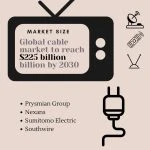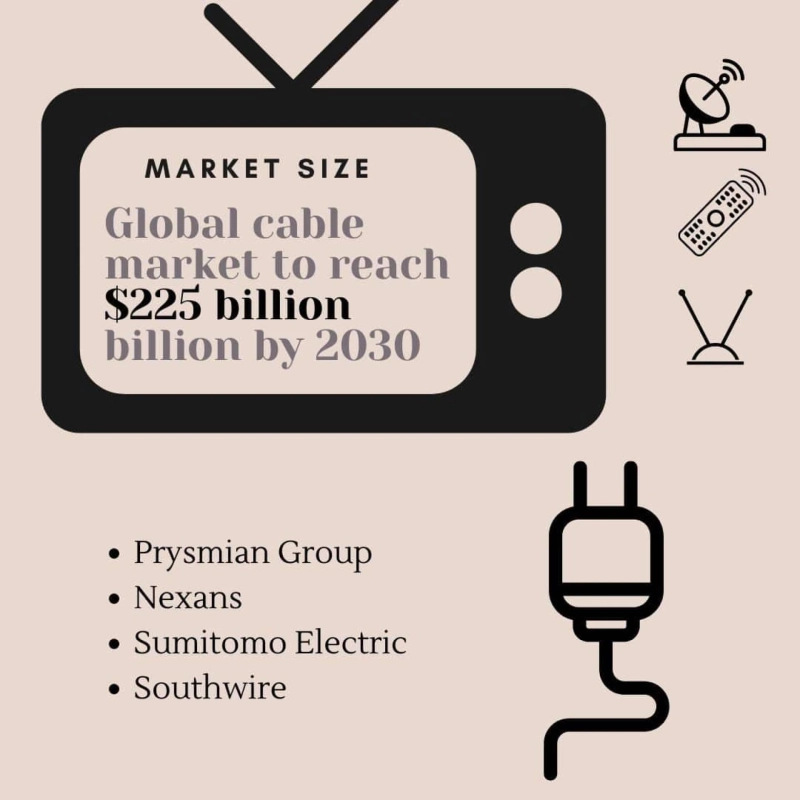According to a recent study, the global cable market size was approximately $145 billion in 2022 and is projected to grow at a CAGR of 6.2% from 2023 to 2030, reaching over $225 billion.
 According to a recent study, the global cable market size was approximately $145 billion in 2022 and is projected to grow at a CAGR of 6.2% from 2023 to 2030, reaching over $225 billion.Market Demand Drivers for cable products include
According to a recent study, the global cable market size was approximately $145 billion in 2022 and is projected to grow at a CAGR of 6.2% from 2023 to 2030, reaching over $225 billion.Market Demand Drivers for cable products include
- Rising internet & mobile data usage requiring network build outs.
- Continued growth in construction of residential and commercial buildings.
- Investments in upgrading ageing electrical grid infrastructure.
- Increasing renewable energy projects requiring cable connections.
- Proliferation of internet-connected devices and need for robust data cabling.
Recent Industry Developments
- Major cable companies are rapidly deploying fiber-optic and 5G networks to offer multi-gigabit internet speeds.
- New subsea cable projects are underway to boost global internet bandwidth.
- Aluminium cables are gaining share versus copper for some applications due to lower costs.
- Vendors are innovating with products like mini data centre cabling to enable edge computing.
Top Players in Cable Market Landscape
- Prysmian Group (11% share, $12B revenue): A global leader supplying energy, telecom, and fiber optic cables. Leveraging M&A and vertical integration strategy.
- Nexans (7% share, $7.5B rev): Focuses on cables for building, utilities, industrial applications. Targeting high-value market segments.
- Sumitomo Electric (4% share, $4.2B rev cabling): Diverse portfolio includes auto wires plus info & energy cables. Strength in Asia markets.
- Southwire (3% share, $6.5B rev): A leading North American wire and cable maker investing in new capacity and products.
- General Cable (2% share, $3.7B rev): Recently acquired by Prysmian. Solid market position in North America.
Other major players include LS Cable & System, Furukawa Electric, Leoni, Fujikura, and Far East Cable.
Strategic Positioning
Top vendors are employing strategies like
- Vertical integration into raw materials like aluminium and optical fiber.
- Developing higher performance cabling products (e.g. fire-resistant, underwater).
- Tailored solutions for focus industries like energy, telecoms, construction.
- Geographic expansion into emerging markets.
- Selective M&A to gain capabilities and cable industry.
Market Segmentation of Cable Industry
The Cable Market is majorly Segmented by these:
Power Cables - $52 billion (36% share)
- Overhead Transmission Cables: $18.5 billion
- Underground Distribution Cables: $21 billion
- Building Wires & Cables: $12.5 billion
Telecom Cables - $49 billion (34% share)
- Fiber Optic Cables: $18.2 billion
- Copper Twisted Pair Cables: $16.5 billion
- Coaxial Cables: $14.3 billion
Data Cables - $43.5 billion (30% share)
- Ethernet Cables: $19.8 billion
- USB Cables: $9.2 billion
- AV/Consumer Cables: $8 billion
- Other Data Cables: $6.5 billion
Challenges, Opportunities and Trends in the Cable Market
Challenges:
Raw Material Volatility - Cable manufacturing relies heavily on inputs like copper, aluminium, insulating materials and optical fiber. Prices for these raw materials can fluctuate considerably, impacting profitability.
Supply Chain Disruptions - The cable industry has intricate global supply chains that can be vulnerable to disruptions from events like the COVID-19 pandemic, geopolitical tensions, port congestion, etc.
Chinese Competition - Low-cost cable manufacturers, especially from China, provide aggressive pricing competition in certain segments like building wire and fiber optic cables.
Cyclical Demand - Much of the demand for cable products is tied to cyclical construction markets for residential, commercial and infrastructure projects which can decline during economic downturns.
Technical Disruption - Wireless technologies like 5G and satellite internet could theoretically make some telecom/data cabling obsolete over the very long-term, though deployment will take decades.
Opportunities:
5G & FTTx Deployments - Nationwide build outs of 5G mobile and fiber-to-the-home/premises networks are driving major new demand for fiber optic and high-speed data cables.
Electric Vehicle Growth - The proliferation of electric vehicles will require upgrading residential and public charging infrastructure, boosting demand for electrical and data cables.
Renewable Energy Projects - Major investments in solar, wind and other renewable electricity sources will necessitate installations of new transmission cables to connect to the grid.
Smart Building/City Demand - Next-generation buildings and smart city projects incorporate vast data cabling for connectivity, energy management, security and other applications.
Emerging Market Growth - There are tremendous long-term opportunities in developing markets like India to build out robust national cable-based communications and electrical networks.
Market Trends:
Aluminum Cable Adoption - With high copper prices, aluminium cabling solutions are gaining interest as a more affordable option for certain stationary power applications.
Miniaturisation of Data Cables - Ongoing innovations in miniaturised, high-density cabling to support edge computing and IoT deployments.
Subsea Cable Expansion - Major new subsea fiber optic cable initiatives are underway to upgrade global internet bandwidth between continents.
Shift to HVDC Transmission - There is a transition towards high voltage direct current (HVDC) cables for more efficient bulk transmission over very long distances.
Vertical Integration Moves - Major cable manufacturers are vertically integrating across raw materials like copper, aluminium and fiber optic strands to enhance supply and margins.
Advanced Cable Tech - Producers are investing in higher performance cable innovations like compact robotics cables, fire-resistant cables, underwater cables, etc.
Conclusion
Despite headwinds like raw material costs and competition, the cable market outlook remains robust through 2030 and beyond. Driven by megatrends like 5G/FTTx, electric vehicles, renewable energy and smart infrastructure, analysts project a $225 billion+ market by 2030 - representing 6-7% annual growth for this vital connectivity infrastructure.



